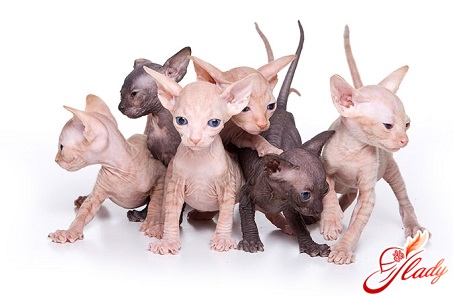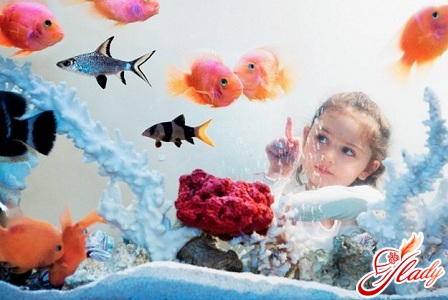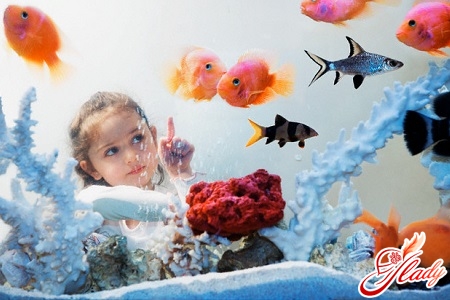 How to care for an aquarium?This question may seem simple, but only at first glance. Do not think that an aquarium is a mixture of water, silt, some types of algae and fish. If you decide to get fish, then you should think a hundred times whether you are ready for such a responsible step, because proper care of the aquarium will require a lot of effort and knowledge. Here you should take into account many factors:
How to care for an aquarium?This question may seem simple, but only at first glance. Do not think that an aquarium is a mixture of water, silt, some types of algae and fish. If you decide to get fish, then you should think a hundred times whether you are ready for such a responsible step, because proper care of the aquarium will require a lot of effort and knowledge. Here you should take into account many factors:
- The size of the aquarium.
- The number of species of fish that you will have.
- Water quality and the possibility of its softening and deep cleansing.
- Soil composition.
- Lighting, which should not be decorative, but should perform the function of creating optimally comfortable conditions for the life of fish.
Everyone is familiar with this from their school biology course.the concept of “biogeocenosis”, which is the best way to draw an analogy between a natural system and the system that you create in your aquarium.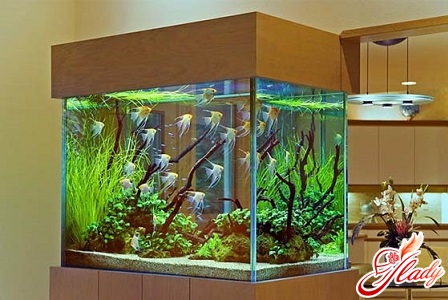
Care of fishes
How to care for aquarium fish - oftenis a question asked not only by amateurs, but also by more experienced people. And it is not surprising - a lot in the aquarium will depend on the correct care of the fish - lifespan, reproduction, cleaning and self-cleaning of the aquarium, etc. It is always worth remembering that you should not only feed the fish, but also turn on the lighting on time, add or change the water, clean the aquarium from those products that prevent the fish from developing and living properly. In short, you should know all the details of how to care for an aquarium fish.
- Feeding fish
First of all, let's talk about the food itself, about what it iswhat it should look like and what it should consist of. It is very important to keep in mind that the food should be complete, balanced and selected for each type of fish individually. Of course, you can use the so-called universal food, but this is a less successful option. As for the types of food, there are several. This is live food, which is usually divided into large (tadpoles, worms, flies, mosquitoes, moths, butterflies and many other crawling and flying insects), medium-sized (aphids, worms cut into pieces, flies and mosquitoes, small flying insects) and small (midges, daphnia, various larvae, etc.). The second type of food is wet fresh products of animal and plant origin (heart and internal organs of animals), plants, etc. You need to be especially careful with this type of food - it is best to first consult a specialist so as not to harm the health of your fish. The third type of food is dry, which includes mixtures (flakes, grain-like mixtures, tablets, hard-boiled yolk, yeast, etc.). Two more types of food deserve special attention - frozen mixtures (two types of freezing can be used - low-temperature and freeze-dried) and vitaminized mixtures with a very high level of vitamin content. It should be borne in mind that passion for mineral supplements is not always useful, since fish can get most of the dissolved minerals and salts from the aquarium water. The world's leading food manufacturers advise, first of all, to pay attention to live food or those foods that are commonly called freeze-dried, since they allow the fish to feel like they are in a natural environment. So, you have decided on the food. Now you need to clearly determine in what quantity to give food and when to feed aquarium fish. To understand this, you need to take into account several factors - the breed and age of the fish, its activity, the presence of by-products of other organisms in the aquarium and the amount of algae. In addition, it is worth keeping in mind the level of water pollution - this will also negatively affect the absorption of nutrients by the fish. In order not to get into trouble, remember a few basic rules for feeding fish:
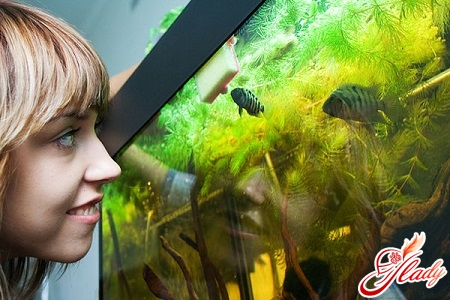
How to properly care for the aquarium?
Proper feeding of fish is very importantcomponent of aquarium care, but far from all. Care should be comprehensive, depends on the size of the aquarium, the filtration and water purification system and much more - this is necessary for the fish to feel comfortable.
- Amount of water in the aquarium
For example, a large volume of water in an aquarium is not soquickly clogged, as a small one. This fact must be taken into account when figuring out how to care for an aquarium. A very common mistake is to buy a small aquarium and stuff it with as many fish as possible. This should never be done - firstly, the water will become polluted almost instantly, and secondly, the fish themselves will suffer greatly.
- Aquarium light
Use of lighting, especially halogen orultraviolet, leads to the rapid death of microorganisms living in the water and on the walls of the aquarium. That is why, when choosing lighting, pay attention not to its decorative and aesthetic functions, but exclusively to practical ones. Before buying lighting, consult with the seller of the pet store.
- Snails and Catfishes
Many people believe that snails areThis is a decorative element of the aquarium, like fish. However, this is not true at all! Snails are excellent cleaners, they are able to quickly and efficiently clean the walls of the aquarium and the bottom. The same is true for catfish - they clean the aquarium no worse than snails. So they are your faithful assistants, which make aquarium maintenance easier.
- Aquarium decor items
If you have houses, driftwood and other things in your aquarium,stones (shells, sticks and much more), then remember that all these items require not just rinsing under running water, but also careful processing, which will ensure the removal of everything that accumulates on them both inside and outside. Sand, which is contained on the bottom, should not be used for a very long time, as various types of waste and toxic substances can accumulate in it. In addition, it can become sticky or slippery, which indicates severe pollution of the aquarium. Therefore, about once every three months, the sand must be completely changed. And even better - refuse to use sand at all - it is best to use medium-sized pebbles as soil.
- Change of water in the aquarium
Clear signs that the water needs to be changedmay be its turbidity, the presence of pieces of decomposed food, a greenish tint and an unpleasant smell. In such a situation, the water should be changed immediately. But it is best not to allow it at all, otherwise your fish may get sick or - worse - die. You can set a water change schedule. For example, once every three weeks, if the volume of the aquarium and the filters installed in it allow this. By the way, remember that you should take care of a quarantine aquarium - it will help the fish wait out the time while the water is being changed, and therefore, protect them from the stress of transplanting into a jar. But fish are very sensitive to this kind of stress and can even get sick. The water that you decide to pour into the aquarium must be settled and purified from impurities of chlorine, reagents and much more. For which you can use special filters or simply settle the water for 24 hours in some container. Otherwise, it will be difficult to call the aquarium maintenance complete. Changed the water? Great, but don't rush to transplant the fish into it right away. It should be remembered that the fish will need several hours to adapt to the new water and its temperature. Therefore, it is best to wait until the water reaches the temperature that the fish are used to. It is advisable not to pour water from the reserve tank into the main aquarium with fish - it is better to use a special net for transplanting everything. We hope that after reading this article, at least in general terms, you understand how to properly care for an aquarium. But, of course, if you still decide to start an aquarium, you will have to learn a lot of new things, read a lot of specialized literature and, of course, try it all out in practice. But imagine what a pleasure it is to watch your small home underwater world! We recommend reading:




